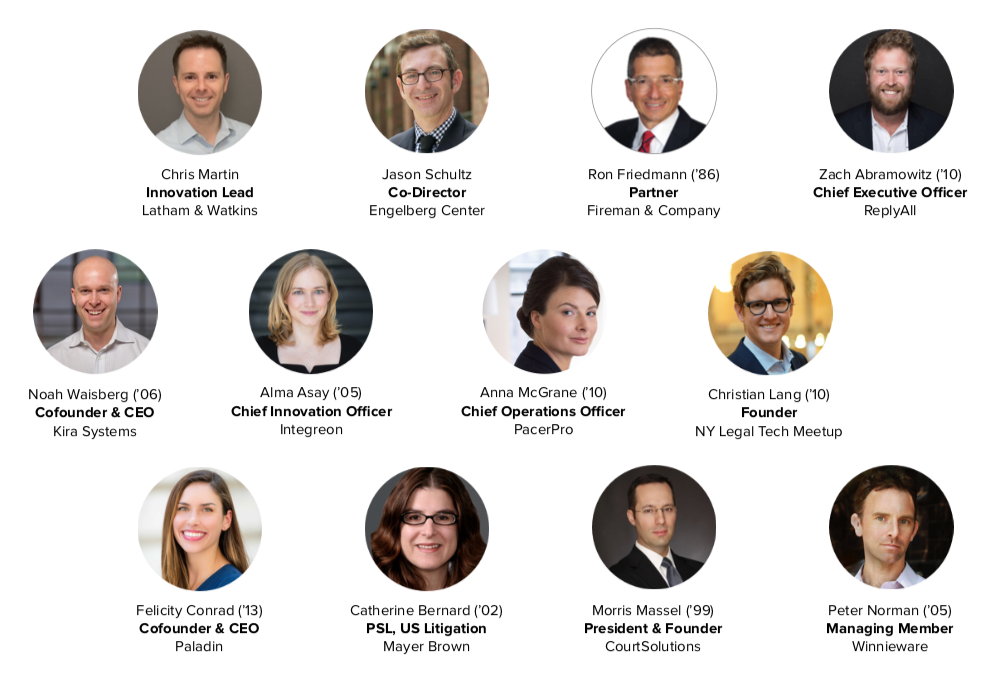Is legal innovation a revolution or evolution? Regular readers know I come out on the latter. I do a deeper dive here drawing on recent news. (Note at the end I share details on an upcoming legal innovation event.)
$65M Investment in Atrium – Revolution Pending?
Ed Sohn and Joe Borstein, writing at Above the Law broke big news on 10 September 2018. Unprecedented $65 Million Investment Shows Atrium Is On To Something Big reported that “Atrium… the startup law firm + tech company (Atrium LLP + Atrium LTS, together referred to as “Atrium”)” raised $65M.
They asked founder Justin Kan about the plans for the funding. Kan answered “The core of our platform is machine learning that parses legal documents to turn them into structured data, then to build applications on top of that data, applications that help attorneys, legal professionals, and their clients with legal work”
$65M potentially buys a lot of innovation. Big news indeed. As I noted on Twitter, however, this investment garnered less coverage and hoopla than did the EY acquisition of Riverview Law or the $50M investment in Kira Systems.
Stumped by that observation, I conducted an unscientific Twitter poll to gauge sentiment:
Andreessen Horowitz @a16z invested $65M in law firm + #legaltech combo @atriumllp, announced Monday morning.
As of now (930pm E Monday), I thought my RSS feed would be filled with stories about this; it was not
So, poll time: WHY SO LITTLE COMMENTARY— ronfriedmann (@ronfriedmann) September 11, 2018
I remain stumped. I/ve read additional articles since but remain unclear what Atrium will do with these funds. So we must wait. I expect we will hear more in the future from them.
Legal Innovation Revolution Thwarted? Waiting for a New Generation of Buyers
Many, myself included, have observed that in-house counsel change buying habits slowly, which in turn slows legal innovation. On Saturday, Jason Barnwell, Assistant General Counsel-Legal Business, Operations, and Strategy at Microsoft offered great insight on this point. He wrote, in a thread started by my Atrium survey, four Tweets:
1/ Agreed.
Loved my startups practice. They went in a lot of directions and they moved up the legal needs complexity ramp as they grew and tested new markets. They were also risk tolerant, embraced experiments, and like self-service tools. Their needs can become mainstream.
— Jason Barnwell (@smuckwell) September 15, 2018
2/ I suspect a big challenges for new players like @atriumllp is mature buyers are not ready to change how they consume legal services, yet. You can only move as fast as your customers. Bringing them along is a process. Once clients born in the new model predominate, watch out.
— Jason Barnwell (@smuckwell) September 15, 2018
3/ We are seeing this play out in our industry. Customers born in the cloud era see the world very differently, and that plays out in their partnering decisions, the services they consume, and how they consume them. A similar pattern play out for legal services too. We will see.
— Jason Barnwell (@smuckwell) September 15, 2018
4/ Also, once the next generation of clients and practitioners see the new way they cannot unsee it. The old ways, even those that have real value, seem silly and antiquated. Convincing my nephew that taxi companies are valuable and serve a purpose is next to impossible.
— Jason Barnwell (@smuckwell) September 15, 2018
When I think about legal innovation, these resonate and support my view that we are in a period of evolution, not revolution.
Succeeding with Legal Innovation Evolution, #1: The Voice of the Client
Jason’s Tweets make me think of legal innovation in two worlds. In revolutionary world, Atrium and other players want to reinvent law practice. They may have to wait for a new generation of buyers. In evolutionary world, law firm incumbents and many legal providers work on innovation with incremental change. My article Law Firm Innovation Takes More than Talk (Legaltech News, 7 September 2018) suggests a recipe with three key ingredients for evolutionary legal innovation:
- Voice of the client.
- Management support.
- Resources to try out ideas.
I illustrate how that can work with an example from my client, Ogletree Deakins.
Succeeding with Legal Innovation Evolution #2: More on Incremental Change
Despite all I have written here, I am still enthusiastic that innovation has become the meme of the year. That creates an environment where firms and lawyers are more willing to consider change. It’s just that they may be more interested in incremental change, which can be just as important. In my day job with Fireman & Company, I’ve done a lot of work with large law firms this year on redesigning Intranets and upgrading document management systems. This may not sound as sexy as much of the innovation buzz. So be it. But it likely will foster more change in how practicing lawyers actually work than many more publicized initiatives. (And good luck measuring the impact of either revolution or evolution, a point I discuss in my More than Talk article.)
When Innovation Revolution Fails (Meet the New Boss, Same as the Old Boss)
Behind Barnwell’s and my observations about innovation in legal, we also have to consider that not all innovation actually works. Especially revolutionary ones. Consider two recent innovations now facing challenges.
In August, the Wall Street Journal published IBM Has a Watson Dilemma. Here is the skinny:
Six years and billions of dollars later, the diagnosis for Watson is gloomy. More than a dozen IBM partners and clients have halted or shrunk Watson’s oncology-related projects. Watson cancer applications have had limited impact on patients, according to dozens of interviews with medical centers, companies and doctors who have used it, as well as documents reviewed by The Wall Street Journal. In many cases, the tools didn’t add much value. In some cases, Watson wasn’t accurate.
Recall that oncology was an area if intense interest and investment for IBM. Money pouring in and having leading experts as partners do not guarantee success.
We may now be learning a similar lesson about self-driving cars. The Saturday (15 Sep 2018) print edition of the WSJ published Driverless Hype Collides With Merciless Reality. The subtitle sums up the thesis nicely: “The bubble around self-driving cars turns into a ‘trough of disillusionment’; firms refactor for much later arrival.” Many companies have indeed made much progress toward the goal of autonomous vehicles. But the real world and “installed base” make deployment beyond limited, controlled circumstances a big challenge. The revolution will take many years.
It’s Not Just “Legal Innovation” That Counts – It’s How We Organize Legal Work
I fear that the focus on legal innovation revolution obscures other ways of generating value for clients, specifically how work is organized and who does it.
General Counsels have made clear they want value – more for less. Of course tech and innovation remain important in delivering that. But we must remember they have no monopoly on creating value. In the last two months, two more large law firms outside the United States announced the opening of low cost service centers for legal support: Ashurst in Brisbane, Australia and Fieldfisher in Belfast, N. Ireland.
Those announcements raise the question of why more US law firms have not opened low cost centers. I believe most of the Top 30 UK firms have such centers by now whereas there are perhaps a dozen among the Am Law 100. These centers do take advantage of lower cost labor but also focus on higher volume legal work and typically industrialize practice with tech and process. (For more on this idea, see my blog post on Law Factory.)
Conclusions
Legal innovation has become the buzz word of the year, displacing robot lawyers (based on legal AI). Like robot lawyers last year, however, the legal innovation buzz this year focuses too much on revolution. While I hope Atrium can disrupt the legal market, Barnwell’s four Tweets suggest any disruption will be slow moving. (Can it still be disruption then?) That speed limit is supported by my comments on voice of the client and incremental change having more impact. Plus the WSJ reports on Watson and self-driving remind us that not all innovations work and, even when they do, much must change for widespread adoption. And lest we forget, even as legal innovators try to foment revolution, large law firms steadily evolve. For more on that point, see my prior post, Why Alternative Legal Provider Market Share May be Limited, .
Addendum #1: Additional Reading by Jae Um
For more on legal innovation, I highly recommend Jae Um‘s three-part essay on the topic. She provides a detailed structural analysis. See Legal Innovation Woes, Part III: Skill Shortage, Emotional Labor & Arrested Development (3 Sep 2018), which links to the prior two parts.
Addendum #2: Event on Legal Innovation at NYU Law
For those interested in legal innovation… if you will be in NYC on Monday, October 22, 2018, I encourage you to attend a panel at my alma mater, NYU Law. The Engelberg Center on Innovation Law & Policy is hosting a panel “Impact of Innovation”. I am a panelist. More info and link to register (free) here. This is the session description:
“Legal tech is here. So is a lot of hype. What is happening today that will actually have a meaningful impact on your practice? Come have a drink and meet NYU Law alumni who left Big Law to found successful legal technology companies, along with leaders in law firm consulting, academia, and media, as they discuss key trends in law & technology.”
Panelists:

Archives
Blog Categories
- Alternative Legal Provider (44)
- Artificial Intelligence (AI) (57)
- Bar Regulation (13)
- Best Practices (39)
- Big Data and Data Science (14)
- Blockchain (10)
- Bloomberg Biz of Law Summit – Live (6)
- Business Intelligence (21)
- Contract Management (21)
- Cool Legal Conferences (13)
- COVID-19 (11)
- Design (5)
- Do Less Law (40)
- eDiscovery and Litigation Support (165)
- Experience Management (12)
- Extranets (11)
- General (194)
- Innovation and Change Management (188)
- Interesting Technology (105)
- Knowledge Management (229)
- Law Department Management (20)
- Law Departments / Client Service (120)
- Law Factory v. Bet the Farm (30)
- Law Firm Service Delivery (128)
- Law Firm Staffing (27)
- Law Libraries (6)
- Legal market survey featured (6)
- Legal Process Improvement (27)
- Legal Project Management (26)
- Legal Secretaries – Their Future (17)
- Legal Tech Start-Ups (18)
- Litigation Finance (5)
- Low Cost Law Firm Centers (22)
- Management and Technology (179)
- Notices re this Blog (10)
- Online Legal Services (64)
- Outsourcing (141)
- Personal Productivity (40)
- Roundup (58)
- Structure of Legal Business (2)
- Supplier News (13)
- Visual Intelligence (14)

